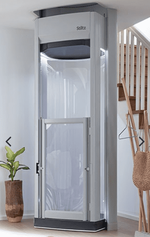This is definitely not for everyone, and in many ways, it doesn't make a lot of sense (especially the cost unless you take into consideration the "cost" of a damaged back/knees), but I thought I'd post this up if for no other reason than to potentially provide a little amusement/interest.
Currently the only permanent space in the house for pins is in a front room upstairs.
When I got TNA, 3 of us manhandled it upstairs, but it was a heck of a struggle - especially the 90 degree turn at the top, so I decided to try to sort out a better solution for the longer term, as TNA wasn't going to be the only pin, and I'd need to be able to get any new pin upstairs, and likely get pins downstairs to swap in future. Given advancing years and vulnerable back/knees etc, it had to be a solution requiring minimal effort, and ideally something I could achieve on my own.
I realise this is a long way from what could be considered "normal", and that my better half is more than a little understanding, but I came up with the idea of installing some type of hoist which would enable the pins to be taken up the stairs, and then slid over the bannister on the landing (thus avoiding the 90 degree bend at the top of the stairs), and lowered onto a trolley.
Well, I finally finished the solution, and am very happy that my Black Knight SOR is now safely upstairs, and I managed it on my own with minimal physical effort.
Bottom of stairs:
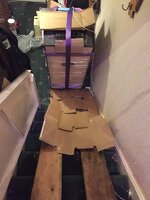
Hoist:
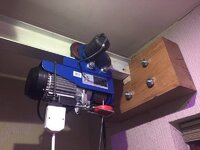
On the way up:
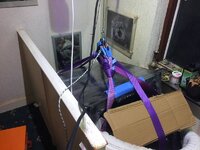
Hanging at the top of the stairs:

On the banister (sitting on memory foam mattress topper for protection):
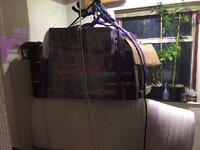
On the landing (lowered onto the trolley):
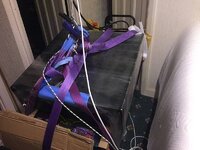
And finally, here's a link to a bit of video on FlickR.
I realise it's a bit Heath Robinson, and probably over-specced - I didn't want to take any risks of it failing, so the hoist will handle 500Kg, and everything else (straps, carabiners, RSJ etc..) significantly more than that.
I hope it provides a bit of amusement, and in any case, I'm happy as it works pretty well, and now means that moving pins (and any other heavy items) up/downstairs is something I can achieve on my own with minimal physical effort!

Currently the only permanent space in the house for pins is in a front room upstairs.
When I got TNA, 3 of us manhandled it upstairs, but it was a heck of a struggle - especially the 90 degree turn at the top, so I decided to try to sort out a better solution for the longer term, as TNA wasn't going to be the only pin, and I'd need to be able to get any new pin upstairs, and likely get pins downstairs to swap in future. Given advancing years and vulnerable back/knees etc, it had to be a solution requiring minimal effort, and ideally something I could achieve on my own.
I realise this is a long way from what could be considered "normal", and that my better half is more than a little understanding, but I came up with the idea of installing some type of hoist which would enable the pins to be taken up the stairs, and then slid over the bannister on the landing (thus avoiding the 90 degree bend at the top of the stairs), and lowered onto a trolley.
Well, I finally finished the solution, and am very happy that my Black Knight SOR is now safely upstairs, and I managed it on my own with minimal physical effort.
Bottom of stairs:

Hoist:

On the way up:

Hanging at the top of the stairs:

On the banister (sitting on memory foam mattress topper for protection):

On the landing (lowered onto the trolley):

And finally, here's a link to a bit of video on FlickR.
I realise it's a bit Heath Robinson, and probably over-specced - I didn't want to take any risks of it failing, so the hoist will handle 500Kg, and everything else (straps, carabiners, RSJ etc..) significantly more than that.
I hope it provides a bit of amusement, and in any case, I'm happy as it works pretty well, and now means that moving pins (and any other heavy items) up/downstairs is something I can achieve on my own with minimal physical effort!
Last edited:


